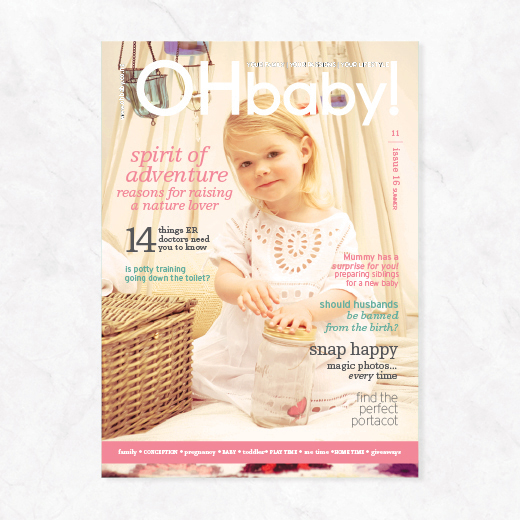Experts tips for helping you and your baby with colic

Colic is the curse of the early months of parenting. If your newborn cries for more than three hours a day at least three times a week he's a colic sufferer. It typically starts around two or three weeks of age and usually lessens around two months. The crying will often start in the late afternoon or evening and can last five to six hours or more. Parents will try anything to stop it but it's often hard to find something that works well. Recognising this is major problem for many new parents, we at OHbaby! have gathered our top experts to pool their wisdom and help you prepare a plan of attack. Remember, try, try and try again. If one remedy doesn't work move on to the next one, as babies respond differently to different treatments.
Lisa Girvan,
mum of three
All three of my babies had colic. With my eldest child it was the worst. For three long months he would cry inconsolably, scream in pain, pull his knees up to his gurgly, tight tummy, arch his back and was often blue around the mouth. He didn't sleep for longer than an hour day or night and on those long, lonely wintry nights, when it felt like I was the only person in the world who was up, jiggling, singing, consoling, I'm sure Sky TV saved my teetering sanity!
Fully breastfeeding, I stressed about what I was eating - what I was doing to cause this distress. I sought advice from myriad sources, ate an extremely bland diet and tried all the natural tonics (for me and baby) that I could get my hands on. With a colicky baby all sorts of people have all sorts of tips to do with holding, feeding, burping and soothing the infant. I could fill pages with what I tried, but in short, none of it worked, until…
A trip to a recommended osteopath in Hamilton changed everything. Paul Hume of Natural Body Link doesn't do just cranial osteopathy (on the vagus nerve which can contribute to gastric reflux) like other baby-focused osteopaths, he also does visceral manipulation of the valves in the tummy.
To get science-y for a minute, this technique, developed by Dr Jean-Pierre Barral of France, works through the nervous system to improve the function of the organs. Paul says a shock to the nervous system (such as childbirth) can tighten the valves and cause them to spasm. If the valve that drains the liver, between the common bile duct and the duodenum, is in spasm it can hold back enzymes from being released from the pancreas which help to break down food. If these enzymes are not present then the food sits there, fermenting, creating its own wind and causing colic. So in layman's terms, the shock of the birth process caused a tummy valve to tighten, trapping the milk in baby's tum which was then fermenting and creating wind.
It wasn't me! It was nothing to do with what I was eating or how useless I was at getting burps up!
Paul did what seemed like a few quick flicks on baby's tum over the top of clothing and my bub was cured in one quick session! Truly remarkable. I celebrated with a sorely missed curry.
I cannot recommend a visit to Paul Hume highly enough. It may sound like pseudo-science, and I was skeptical at first, but a 100% success rate is all the evidence I need. He fixed all three of my children's colic in one session each and for an exhausted, stressed mother almost at breaking point, this was pure magic.
Dr Maud Meates-Dennis
paediatrician
Infantile colic is not a medical condition, it's a description of infants who cry excessively. To understand excessive crying, you need to understand what is normal, and it is normal for babies to cry. There is an escalation in normal baby crying from about two weeks until about two months when babies, on average, cry for about two to two and a half hours per day and then the crying usually reduces.
To reduce the frustration that can often accompany a crying infant, the National Center on Shaken Baby Syndrome (NCSBS) in the United States has introduced the concept of PURPLE crying. Similar programmes are being introduced into New Zealand.
No known cause
Studies have failed to show any pathological cause for infantile colic, sometimes called PURPLE crying. Purple crying does not describe the colour of the baby - it's an acronym:
P: Crying increases every week from about two weeks with a peak at about two months of age with less crying by three to five months of age.
U: The crying is unexpected and unexplained. The baby starts and stops crying for no apparent reason.
R: The baby resists soothing so often nothing you do will settle your baby.
P: The baby seems to be in pain with grimacing or drawing up the legs.
L: The periods of crying can be long, up to five hours or more.
E: The crying episodes often occur in the evening or late afternoon.
We know that colic is often associated with passing wind but that may be as a result of the baby crying and swallowing more air rather than being the cause of the crying. Babies who cry excessively do not have emotional issues or other problems later in life, so crying a lot does no harm.
When dealing with a crying baby, the important thing to remember is that not all soothing techniques or treatments will work all the time in all babies and sometimes nothing will work at all. If nothing works, it is important not to get frustrated. It is not a failure to be unable to soothe your baby.
Soothing techniques
- Increase the comfort - carry, walk and talk to your baby.
- Make sure he is dry, fed and burped.
- Make eye contact with baby.
- Pick your baby up, try changing his position or try a baby sling.
- Take him for a walk to get the fresh air.
- Talk gently or sing to your baby.
- Don't stop these things immediately when your baby settles. Keep doing them so your baby remains settled for longer.
- If you get frustrated put the baby in the cot and walk away until you feel calmer or someone else can attend to your baby.
- Kiss your baby - it will calm you both!
- Some babies respond to a warm bath and massage.
- Some babies respond to white noise, such as the vacuum cleaner.
- Some babies respond to car rides.
Medication and treatments: A variety of medications, dietary changes, herbal and alternative treatments have been used for colic and can work. But research studies have failed to show any of them being overwhelmingly effective. I would not advise any medication or treatment that is expensive. If one thing doesn't work after a week or two you can try something else, but don't be surprised if nothing works.
Popular treatments include Infacol, Gripe Water, Lactase and sucrose solution. While there's no conclusive evidence of any benefits, these treatments are unlikely to cause any harm. Sucrose solution has been shown to benefit some babies.
Dietary changes: Some studies have shown benefits from hypo-allergenic diets but unless there are other features of allergy, (such as poor growth, loose stools or severe eczema), I would not advise changing to a hypo-allergenic diet.
Some studies have shown benefits in using probiotics but it may depend on the type of probiotic. These are unlikely to cause any harm.
Herbal remedies: Studies of fennel, particularly tea, have shown benefit in some studies. Breastfeeding mothers could try it. Herbal tea should not be given to babies as they should have only milk to get enough calories for growth.
Dorothy Waide
baby whisperer
Colic is often referred to as the six o'clock blues but it doesn't have to feel that way. Here are some ways to help manage the symptoms of colic.
My top tip is to check the position of your baby's tongue - it needs to be at the base of the mouth to effectively bring up wind. During the first 10 days of life some babies don't require a lot of burping as their digestive systems are slowly getting used to milk passing through. If you do have a newborn who needs burping, begin with gentle rubbing and patting movements up and down his back. As your baby gets older you can be firmer with your actions to encourage the more difficult burps to surface. When burping, old your baby so he is facing you with a straight back. If your baby is curled up straighten his body by putting him over your shoulder. Now, placing your thumbs under the front pelvic area and palms and fingers on the back of his bottom, lift him slightly out from your body. Then hold him firmly over the bottom area with the same arm that's holding him. DO NOT pull his legs downwards from the socket as you could dislocate his hips.
When rubbing your baby's back, make sure your thumb and fingers are rubbing up and down the sides of the body. Gently using your palm, massage the middle of the back in circular clockwise motions. Rub up the spine, coming back down the sides.
Changing a baby's nappy often alleviates wind. The leg movement during changing, followed by going back over your shoulder, is effective in bringing the bubbles to the top.
Another option is placing your baby over your knees, tummy down, with his left side furthest away from you. If you pat his tummy from underneath you will sometimes hear a sloshing noise. Once he has burped, the sloshing noise disappears. Then try tummy massage clockwise, or massage using a gentle in and out motion followed by gently moving the legs in towards the tummy. Finish with moving both legs together, while bent, to the left and right and then straightening again. Massaging your baby's tummy with your fingers on either side going in and out can help. If they have bowel gas then using the fleshy part of your hand and massaging downwards with very light pressure will help.
Some babies need more burping than others. In general, spend no longer than five minutes doing these above techniques. The analogy I like to use is a bottle with curves in it; trying to move bubbles from the bottom, up and around the curve to the top would be extremely hard. Keeping your baby's body straight makes it easier to release wind.
Lastly, a busy household can contribute to your baby's stress levels. The more relaxed the environment, the more relaxed your baby will be.
Dorothy's website - babywithin.co.nz
Dorothy's Facebook page - facebook.com/BabyWithin
Natasha Berman
naturopath
Colic is distressing for baby and mother but it's not an illness, it is a temporary physical disorder that is often confused with genuine medical conditions such as milk protein allergy, a lactose intolerance or gastro-oesophageal reflux. Colicky babies do not fail to thrive. Despite the tears, babies with colic are otherwise healthy and happy. In my experience the causes of the symptoms of colic include:
- Inadequate burping techniques and/or not all wind being brought up which causes heartburn and trapped gas. This then causes the baby to feed insufficiently at subsequent feeds and become distressed, failing to settle properly so causing more distress through lack of sleep. This is a vicious cycle that needs to be broken by good winding and a clear routine of feeding and sleeping.
- The immaturity of the baby's digestive system with intestinal muscle spasms causing abdominal cramps. Again, this is where winding techniques play a vital role.
- Overfeeding, snack feeding or an overactive breastmilk let-down reflex providing too much milk too quickly. This causes the baby to gulp down too much air, causing wind. Once again winding techniques are most important.
- A baby may be anxious or distressed because of stress in the home. A stressed mother will affect the nervous system of the baby and milk supply.
- Mother's diet too rich in simple carbs and too low in quality protein.
- Food intolerances such as wheat, yeast, sugar, chocolate, coffee, tea, eggs, peanuts, dairy, fruits such as citrus and vegies such as onion, cabbage and garlic.
Treatment
Effective burping techniques are the most important treatment for colic. I recommend people look for seminars run by The Parents Centre.
- Also, feed your baby in a calm, relaxed atmosphere away from stimulating environments and bright lights.
- Warmth is very soothing - feed your baby in the bath! It is both relaxing and great for skin-to-skin bonding.
- Massage is also soothing. Rub the tummy clockwise, rub the back anti-clockwise, do cycle motions with baby's legs, and give a foot massage.
- You could also try Qbaby Colic Drops to ease the spasm and distress. Herbs such as aniseed, chamomile and fennel help ease symptoms and can be made into tea and given directly to baby.
- Use a high quality acidophilus probiotic supplement such as Bioceuticals Baby Biotics to replace good bacteria in the gut.
- Breastfeeding mothers can take EFA Essentials, or give a formula-fed baby a teaspoon of Childlife EFA daily.
- Breastfeeding mums can also drink Qbaby Galactogogue Tea which has herbs such as fennel and licorice.

AS FEATURED IN ISSUE 16 OF OHbaby! MAGAZINE. CHECK OUT OTHER ARTICLES IN THIS ISSUE BELOW

















